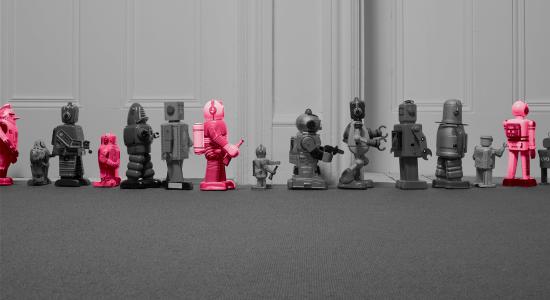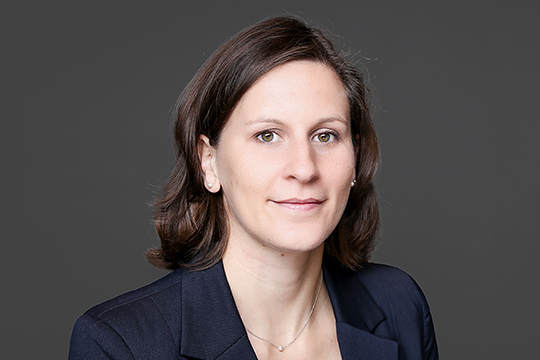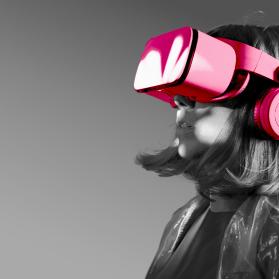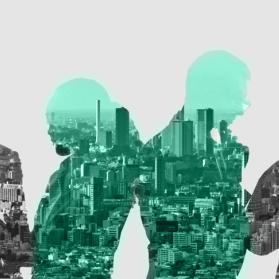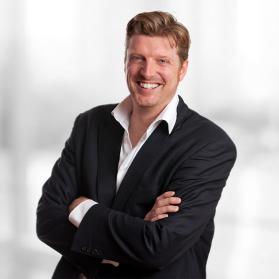The COVID crisis had a previously unimagined impact on the world of work and the way we define collaboration. After almost three years of the pandemic, the New Normal (so new just a short time ago) has now become a fixed element of the working world — or so one might think. But is that really the case? Detecon’s LinkedIn format State of the Normal sought to answer this question — with surprising results.
State of the New Normal was a series of short interviews during which business leaders and New Work thought leaders from a variety of companies and industries were questioned about their views on the new reality of work. Depending on the expertise and field of activity of the interviewees, the focus of the topics was on one of the dimensions of Detecon’s New Work approach to establishing new working worlds and working methods in organizations: People & Engagement, Places & Spaces, Tools & Technologies, or Organization & Frameworks.
The State of New Normal series started in October 2021 and includes 19 short interviews published on Detecon’s LinkedIn channel. Every interviewee was asked three questions from a standardized questionnaire and requested to respond briefly and concisely in “Twitter length” (i.e., with a maximum of 240 characters). As apparent from the brevity of the interviews, our aim was not to obtain exhaustive content in the replies to the questions. Instead, the goals were to obtain focused responses and to draw a holistic picture of the New Normal from the feedback as a whole. We have summarized in the following the most fascinating results and insights from the interviews along the four New Work dimensions.
People & Engagement
In the dimension People & Engagement, the focus is on information, support of change, and empowerment of employees and managers for New Work, the only way that New Work can be brought to life in an organization.
We asked our interviewees what they would not want to see return even after the end of the pandemic, how they prefer to organize their personal workday, and what they think is absolutely essential for Remote Leadership.
When the keyword “flexibility” was mentioned, everyone agreed that no one would miss being tied to a specific workstation or would want to give up the new-found flexibility. As Dennis Klosterhalfen, Director HR MiSUMi Europe GmbH, noted: “We should not take a step back in our mindset and try to force everything back into a corset and instead trust that flexibility will be used for the benefit of the company and the employees.”
Within this framework of flexibility, most people enjoy a good mix of working in the office and from home. They choose the place of work best suited to the activities on the agenda and value the time they spend together with their colleagues in the office even more.
While employees can enjoy the benefits of flexible work structures, managers are confronted with greater challenges. But there is a recipe for success for them as well, and its key ingredient is trust; ultimately, “only through trust can team and company loyalty be maintained, while good communication is essential,” noted Kristina Zabbei, Program Lead We.Work.New. at T-Systems International GmbH.
Places & Spaces
In the dimension Places & Spaces, the emphasis is on the transformation of the physical working environment. While an appropriately designed, modular work environment enables flexibility in workplace choice, supports activity-based working, and increases employee creativity and productivity, it can also generate savings by reducing space requirements and modifying infrastructural demands.
We gained fascinating insights into daily work routines within this dimension as well, now that the regulations imposed on our lives by the pandemic are becoming more relaxed. There is little that companies can do — nor do they have the resources — to influence how employees set up their workplaces at home, so the challenge lies in making the offices more appealing. There is a desire to move forward with the technical development of these spaces and to imbue them with life and positive energy: “Make the working world so attractive and diversified that people are happy to make the commute.” — Christina Thubeauville, interior designer.
Even though many would like to retain the freedom and flexibility they have come to enjoy even when COVID has become a thing of the past, our interview partners look forward to the days when people will be together in the office and can once again share thoughts and ideas with colleagues. One of the challenges, however, still seems to be finding a hybrid model that suits everyone — along with the individual flexibility in selecting the individual workplace, the decision in favor of activity-based work must be made and supported by the entire team (for what activities do we come together in what setting to achieve the best possible result?).
Tools & Technologies
The dimension Tools & Technologies includes hardware and software for New Work applications extending to sensor technology in the office space. For one, the right hardware equipment guarantees optimal productivity and health conditions for mobile working; for another, collaboration and communication while working flexibly is supported by a focused software tool landscape.
Our interviewees and their companies have done a good job of adapting their IT infrastructure to mobile working. The multitude of new tools, initially seen as a major challenge, is now — in conjunction with the appropriate empowerment — perceived as a major advantage. The various tools are the means for realizing more productive design and effective structures in work procedures: “Offering support to employees in the form of various enabling formats and demonstrating the advantages of a more networked tool world is a help here,” says Jonas Hellweg, People Experience Consultant at T-Systems Multimedia Solutions GmbH.
In general, everyone agreed that IT is an important part of business and a necessity for the modern workplace. Hellweg sees Tools & Technologies as “a key cog in the overall New Normal picture.” According to Dirk Ramhorst, CIO/CDO at Evonik, IT is “no longer just a commodity, but on a par with the business.”
The task is not complete when the hardware infrastructure and the required software have been provided, however. These components develop their full potential solely when the appropriate mindset has been created, so IT must “enable employees to fully embrace virtual collaboration — in terms of infrastructure, tools, and mindset,” says Ramhorst. With the right tools and technologies, “collaboration and culture [within the company] can also be fostered even if working from home becomes the default mode for work,” adds Ivan Cossu, co-founder and CEO at deskbird.
Organization & Framework
The dimension Organization & Framework comprises the organization-specific vision and guardrails necessary for a forward-looking New Work concept. We also include under this heading regulations such as work agreements on mobile working or IT security.
When asked what the world of work and work methods would look like once the coronavirus pandemic had been overcome, the interviewees described the world of work of tomorrow in the following terms: visionary, innovative, self-determined, reflective, agile, and digital. “Hybrid working will play a key role in the future. What we do will determine where and how we do it. Offices will become the sites where people meet and share ideas and experiences.” — Jennifer Bath from T-Systems International. These concepts cannot be realized without a cultural transformation in companies.
When speaking about the unresolved challenges relating to the New Normal, some interviewees mentioned sustainable anchoring and long-term establishment in the company. Moreover, they do not expect to see a universal New Normal because companies vary so widely in their structures. Clemens Suerbaum, spokesman for the Center for Digitalization Bavaria (ZD.B), commented: “It will not be possible to avoid various forms of ‘New Normal’ even within one company.”
Another challenge concerned the personal contact among colleagues. According to strategy consultant and digitalization expert Bernd Hilgenberg, virtual working itself still poses a challenge: “Working on virtual teams requires an especially high degree of self-organization and structure. Many employees have never learned these skills, and they will have to work hard to make up this deficit.”
The freedom to choose flexibly the place and method of work, better integration of the family thanks to mobile working, and the combination of digital thinking and agile action are aspects that the interviewees would definitely like to retain.
Conclusion
The short interviews in our State of the New Normal series have given us a broad range of viewpoints on the New Normal and insights into its implementation in various companies. Despite the brevity of the responses, a larger picture emerges that certainly provides indications of the status of the New Normal that has been reached after more than two years of pandemic. State of the New Normal was never intended to be an exhaustive study, and so there are no definitive answers. Moreover, the world of work is heterogeneous and in a constant state of flux, and so any indications, no matter how reliable they may appear, may be superseded by different trends tomorrow. After all, if anything characterizes the New Normal, it is the agility and flexibility associated with it.


